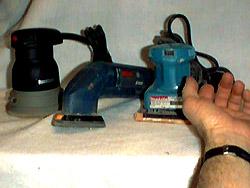Finishes
Before the finish can be applied,
its important that the bow be thoroughly sanded to remove any
unsightly blemishes or scratches. I like to start out sanding
the riser with 80 grit paper. This coarse paper helps round off
any unwanted ridges that have been left from the shaping process.
I then progress through 100 grit, 150 grit, 220 grit and finally
320 grit. Its time to sand the fiberglass when you have loaded
your sander with 220. Sanding the glass is necessary to guarantee
adhesion of the final finish. Once you have the bow sanded and
are ready to apply the finish, wipe it down with a tack cloth.
This sticky material will remove any dust or sanding particles.
Don't rub hard with the tack cloth however since that can leave
a waxy residue. Below are some of the tools commonly used during
the sanding process.

Pictured above are several types of sanders. Left to right
are: random orbit, detail, finish and the ever popular
palm sander.
Its important to put a high quality
finish on your bow since it protects your investment in both
time and money. There are numerous finishes that will provide
this protection. Some of the most commonly used are Fulle Plast,
Thunderbird and numerous brands of polyurethane.
Fuller Plast, made by Fuller
O'Brien, is probably used by more bowyers than any other finish.
It is a two part catalyzed varnish which builds quickly to a
very deep looking, durable finish. FP is thinned using lacquer
thinner or Synol thinner, and when thinned can be used as its
own filler by sanding after each coat until the pores are filled.
According to the manufacturer, there are no compatible commercial
fillers available. It does have to be applied using a spray gun
or air brush and once dry it is difficult to clean off your tools.
It dries to the touch in approx. 20 minutes and should, according
to the manufacturer, be recoated within 2 hrs.
Thunderbird when applied is a
lacquer but converts to a polyurethane in approx. 6 hrs. This
characteristic gives you a 6 hour window to complete your finish
work. If you try to apply coats after the conversion has taken
place, the lacquer being applied can soften the polyurethane.
Thunderbird can be brushed on, however I've never tried it so
I can't speak from experience regarding this application technique.
There is a compatible Thunderbird filler also available which
works very well. Any unused amount of Thunderbird, since it is
not catalyzed, can be returned to its storage can without contaminating
its contents. Clean-up can be easily accomplished with lacquer
thinner.
Polyurethanes have been around
for a long time and have been used to coat many bows. They can
be brushed or sprayed with excellent results. The drying time
is quite long and on some oily exotic woods such as Cocobolo,
it never seems to completely dry. Paint thinner works for clean
up on oil based poly and water for the newer water based urethanes.
In the past, water based urethanes had a tendency to yellow,
but newer outdoor formulas have alleviated that problem.

Left to right: Fulle Plast with catalyst and synol thinner.
Thunderbird finish, thinner and sealer. Outdoor water based polyurethane.
All of these finishes should be considered harmful to your health
when their vapors are inhaled. Respirators should always be worn
when these or any other finishes are being applied.

